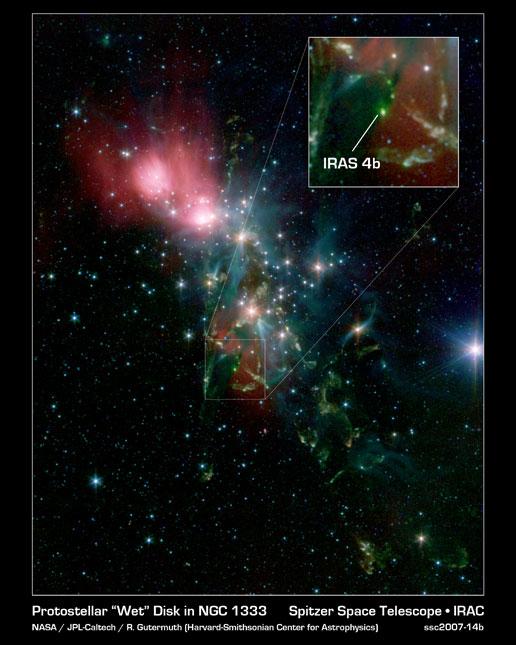
A Spitzer false color infrared image of a region of star formation, NGC 1333, with an insert showing one young stellar object, IRAS 4-b. CfA astronomers have now analyzed spectra of 130 such objects in this cloud and one other.
The very early stages of a new star's life are critical ones, both for the star itself and for its future planets (if any are to develop). The process of star formation, once thought to involve just the simple coalescence of material under the influence of gravity, actually entails a complex series of stages, with the youngest stars assembling circumstellar disks of material (possibly preplanetary in nature), for example. Understanding these early stages has been difficult for astronomers, in part because because they take place in nurseries heavily obscured by dust, but they are critically important to an understanding of how our young solar system and its planets were born and evolved.
The Spitzer Space Telescope and its two infrared cameras have enabled astronomers during the past few years to discover and study large numbers young stellar objects ("YSOs") in star forming clouds of gas and dust. Its large infrared images can penetrate the dusty veil and pinpoint the many faint stars, cool and red, that are between about one and ten million years old, or sometimes younger.
A team of eleven CfA astronomers led by Elaine Winston, together with two colleagues, has analyzed 130 YSOs found with Spitzer in two nearby clusters of stars, and also seen with the Chandra X-ray Observatory. Their pioneering follow up studies on these YSOs used ground-based facilities, especially the CfA's Hectospec instrument on the MMT telescope in Arizona. While the red Spitzer colors of the sources are excellent indicators of the stars' youth, the spectra allow for more quantitative analyses of temperatures, element abundances, activity in stellar atmospheres, outflows, and accretion onto the disk - all quantifiable measures of a star's mass, young age, and disk properties.
The scientists find that some of the spectral features - light from hydrogen, for example - help to identify the presence of disks, while other features like a signature of lithium atoms can pin down the ages of these stars. Their spectroscopic work corroborates or refines earlier age estimates based solely on the general colors. It also finds that in these two clusters a population of stars younger than about 3 million years old exists among what appear to be other stars as much as ten million years old (for comparison, the sun is about 4.5 billion years old); both populations have disks. This mix of ages within the same region had previously prompted skepticism about the reliability of the color analyses because
conventional wisdom holds that older stars should lose their disks. The new results, by putting the earlier measurements on more solid ground, confirm that there is a real mystery to resolve: can stars that have evolved past extreme youth really have disks and not protoplanetary systems, or is the process of estimating the ages of these stars in some way flawed?